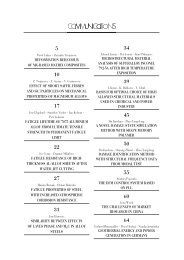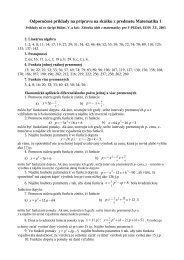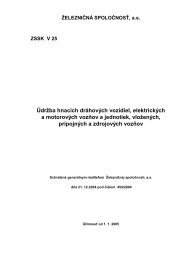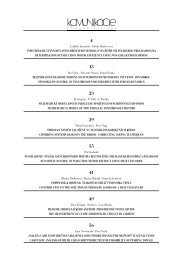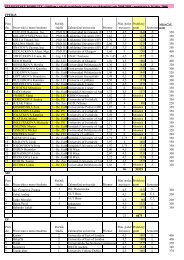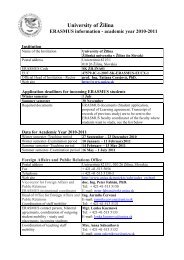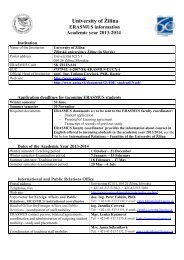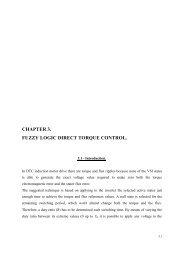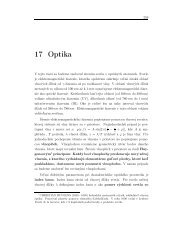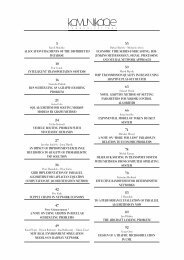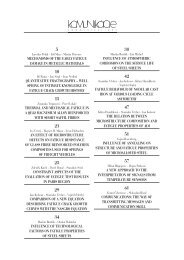simulation of torsion moment at the wheel set of the railway vehicle ...
simulation of torsion moment at the wheel set of the railway vehicle ...
simulation of torsion moment at the wheel set of the railway vehicle ...
Create successful ePaper yourself
Turn your PDF publications into a flip-book with our unique Google optimized e-Paper software.
Fig.1 3D model <strong>of</strong> <strong>vehicle</strong> (MSC.ADAMS/Rail [10])finite element method <strong>the</strong>ory. Because <strong>of</strong> special model parameters<strong>set</strong>ting (in accordance with <strong>the</strong> ADAMS system), it behaves like<strong>the</strong> system <strong>of</strong> no-mass frames. We can proclaim th<strong>at</strong> from <strong>the</strong> point<strong>of</strong> view <strong>of</strong> commercial programme packages fe<strong>at</strong>ures, <strong>the</strong> DELTAprogramme with its working fe<strong>at</strong>ures is closer to <strong>the</strong> FEM (ANSYS– <strong>the</strong> Transient analysis part) system than to MBS (ADAMS)system. It is possible to take into account <strong>the</strong> flexibility <strong>of</strong> modelledbodies when <strong>the</strong> real stiffness and cross-sections parametersare known and <strong>set</strong> as input parameters for a comput<strong>at</strong>ion. Theprogramme was built in <strong>the</strong> environment <strong>of</strong> <strong>the</strong> programme languageDELPHI for an oper<strong>at</strong>ion in <strong>the</strong> environment <strong>of</strong> <strong>the</strong> MSWindows XP oper<strong>at</strong>ional system. It was designed on <strong>the</strong> base <strong>of</strong> anopened component system. The programme DELTA allows performingst<strong>at</strong>ic and dynamic mechanical systems analyses. An input<strong>of</strong> d<strong>at</strong>a <strong>of</strong> a <strong>vehicle</strong> mechanical system is carried out with <strong>the</strong> help<strong>of</strong> node points and elements: a linear spring, nonlinear spring,a beam, a linear damper, nonlinear damper and mass point.Boundary and starting conditions:– prescribed displacements, velocities and acceler<strong>at</strong>ions <strong>of</strong> nodes;– prescribed revolutions, angular velocities and angular acceler<strong>at</strong>ions<strong>of</strong> nodes;– prescribed forces and torques acting in nodal points;– prescribed acceler<strong>at</strong>ions acting on a <strong>vehicle</strong>.Methods for dynamics solution:– <strong>the</strong> eigenfrequencies and eigenvectors assessment with <strong>the</strong> help<strong>of</strong> Jacobi’s rot<strong>at</strong>ion method;– a response analysis evoked by harmonic excit<strong>at</strong>ion;– a direct solution <strong>of</strong> a model oscill<strong>at</strong>ion in <strong>the</strong> time domain with<strong>the</strong> following methods: <strong>the</strong> differential method, <strong>the</strong> HHT- method,<strong>the</strong> method <strong>of</strong> linear acceler<strong>at</strong>ions, <strong>the</strong> Newmark method, <strong>the</strong>Wilson- method and <strong>the</strong> Crank-Nicolson method.Equ<strong>at</strong>ions solution methods (solver) are Frontal elimin<strong>at</strong>ionand L-U decomposition.The otput is graphical and textual. The eigenfrequencies andeigenvectors assessment was performed with <strong>the</strong> Jacobi’s rot<strong>at</strong>ionmethod. A response analysis from harmonic excit<strong>at</strong>ion and a directsolution <strong>of</strong> model oscill<strong>at</strong>ion were performed in <strong>the</strong> time domain.Fig.2 The DELTA programme main screenwhen <strong>the</strong> menu are openedThe Newmark modified method was used for <strong>the</strong> direct solutionin <strong>the</strong> time domain. This method is known as <strong>the</strong> ”HHTmethod“.The method was modified for <strong>the</strong> solution <strong>of</strong> dynamicsystems with nonlinear members. The usage <strong>of</strong> this method hasbeen recently very relevant in <strong>the</strong> field <strong>of</strong> technical comput<strong>at</strong>ionsperformance. The main advantage is in <strong>the</strong> decrease <strong>of</strong> time whichis necessary for computing. The linear algebraic equ<strong>at</strong>ions systemwas computed with <strong>the</strong> help <strong>of</strong> <strong>the</strong> Frontal elimin<strong>at</strong>ion method.This method is suitable for big systems <strong>of</strong> linear equ<strong>at</strong>ion solution,known in connection with numerical analyses based on <strong>the</strong> Finiteelement method <strong>the</strong>ory. The comput<strong>at</strong>ional model was built up from80 nodal points and 132 elements. The model has 456 degrees <strong>of</strong>freedom, <strong>the</strong> comput<strong>at</strong>ional front width is 66. All <strong>the</strong> amount <strong>of</strong>track sections is 257, which represents <strong>the</strong> 1285 seconds <strong>of</strong> <strong>vehicle</strong>running.COMMUNICATIONS 3/2008 ●11



